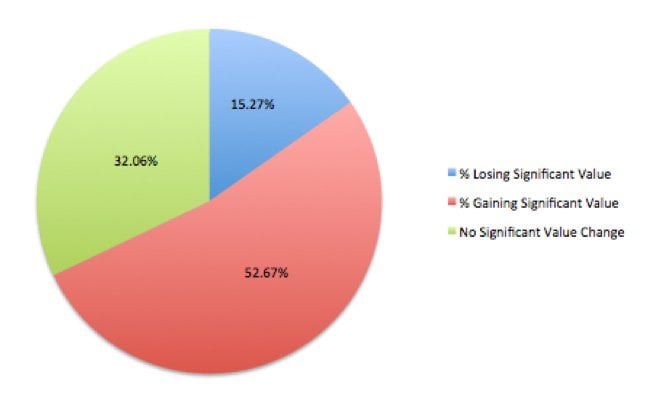Rookie Investments

The off-season for dynasty fantasy players often centers around evaluating the incoming rookie class and making plans for how they can effectively turn their draft picks into the base of a competitive team. There are a variety of ways to accomplish this goal, including trading draft picks for veteran players or stock piling picks in an attempt to find the next young dynasty superstar. While there is no one right way to build a dynasty juggernaut, you almost can’t go wrong by loading up on rookies.
There has been a shift in the dynasty scene in recent years. We often talk about the change from running back domination of several years ago to the wide receiver supremacy we see in most leagues today, but that is not the only change. It seems that each year, rookies and young players in general are valued to a higher degree by dynasty owners. Much of this is deserved, as younger players have been playing at a high level earlier in their careers than we once saw, but there is also the matter of some owners chasing the “next big thing.” With this mindset, rookies, second year players and all young players have never been more valuable. How should dynasty owners act on this? Simply by acquiring as many rookies, either through the rookie draft, a startup draft or through trade, as possible.
[am4show have=’g1;’ guest_error=’sub_message’ user_error=’sub_message’ ]
Loading up on draft picks and the rookies they eventually become has been a longtime strategy of mine and has served me well, but I’ve always understood and respected those who chose to build their teams in a different manner. I obviously still do, but I also don’t think the idea of rookies gaining value can be refuted. To learn if my hypothesis was correct, I dug into the dynasty startup average draft position (ADP) data from the past two years. I have recently started my third year of collecting year-round ADP data and I have found it to be invaluable. Not only can it be an excellent resource to use during a startup draft, but can also offer us perspective when viewing data from past seasons.
My data search and this line of thinking was inspired by the past work of Eric Hardter and his exceptional work Take Your Pick and Perception Deception. I was reminded of Eric’s work from last off-season after reading a series of Tweets from Footballguys’ Adam Harstad discussing the optimism dynasty owners are filled with regarding young players. Does that optimism always work out? Certainly not. Consider young players like Cordarrelle Patterson and Justin Hunter, who were major disappointments in 2014 after dynasty owners spent early draft picks on them last off-season.
What’s important to note is regardless of the events of a rookie’s first year in the league, they almost always maintain or grow their value. I’ll say that one more time to be clear….nearly all rookies maintain or improve their value over the span of their first season in the league. How do I know this? The ADP data tells us so. Admittedly, the data is limited. As I already mentioned, 2015 will be my third year collecting ADP data, so I focused on just the past two NFL draft classes in my study.
Before I share some of that data with you, let me make this clear. The fact that these young players are gaining value does not guarantee your dynasty team production, but it does at least allow you a full year to monitor the player and make an informed decision on how to act, keep, release or trade the player. What you can expect from these players on the field and in your fantasy lineups was well covered by Dr. Scott Peak in his article, Rookie Fever. Instead, I will focus, as I often do, on player value and how you can maximize that value to build a dominant dynasty team.
The Rookie Player Pool:
I began by looking at all rookie quarterbacks, running back, wide receiver and tight ends who were either drafted in DLF’s off-season mocks or who scored fantasy points during the 2013 and 2014 seasons. This provided a group of 131 players. I charted the ADP of each of those players for the off-season before their rookie season and compared that to the same data following their initial year in the league.
Also one other note regarding the ADP data: all of the data listed below refers to the combined 2013, 2014 and 2015 off-season ADP, combining each of the six monthly drafts from January through August (January-February for 2015 data).

After studying the data, I chose to represent a change in value of 12 of more draft positions in either direction as “significant.” There were many swings of less than two draft positions, which is not a significant change, especially when factoring in the additional players that enter the draft pool each year as members of the new rookie class.
A few other notes about this data…
- Of the 29 players who lost value, only four of those were top 100 startup draft picks in their rookie year.
- While nearly one-third of the player pool lost some value from year one to year two, about half of that group dropped by one round’s worth of picks, or less.
- Also, of those 39 players, 21 of those players had a rookie season ADP of 200 or higher, meaning expectations were already low for those players. It’s always nice to hit on a late-round draft pick, but more often than not, those players are on the waiver wire and not your starting lineup.
- After one full season, over 50% of rookies have gained over a full startup draft round (12 picks) of value.
- Only about 15% of rookies have lost significant value. That represents about 8 rookies per year, with many of those being later round fliers who might not even be selected in a typical rookie draft.
- While only about half of the players losing value lost significant value, while the large majority of players gaining value (85) rose more than 12 draft picks. If a player does gain value, this shows us it’s likely to be
- Again, this data does not suggest that all rookies, or even the majority of rookies will become fantasy starters, but it does show that through the first year, they are save investments for your dynasty team. Once that year is complete, you’ll need to make a case-by-case decision what to do with that player.
- For those are you who are more visual, here’s one more look at the significant ups and downs of rookie player value.

Next time, I will further break down this data and examine the past two draft classes, each position and the players drafted at the top of their rookie classes.
Follow @RyanMc23 on Twitter
[/am4show]
- DLF’s April 1QB Trade Value Chart - April 24, 2024
- Monday Mocks: Expert 2024 Rookie Mock Draft - April 22, 2024
- Monday Mocks: 2024 Landing Spots - April 15, 2024


































































